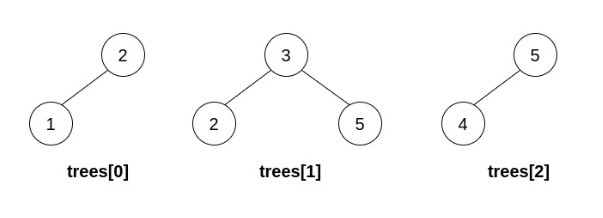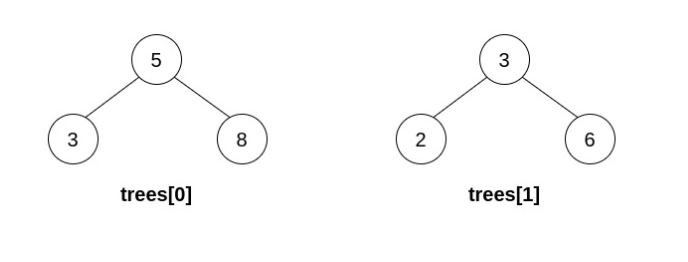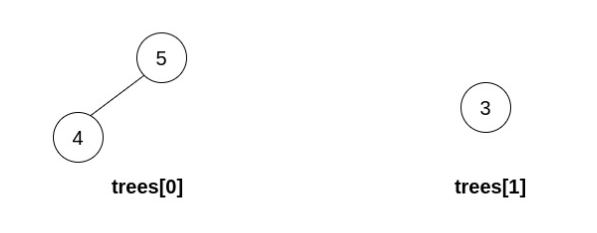1932. Merge BSTs to Create Single BST
Description
You are given n BST (binary search tree) root nodes for n separate BSTs stored in an array trees (0-indexed). Each BST in trees has at most 3 nodes, and no two roots have the same value. In one operation, you can:
- Select two distinct indices
iandjsuch that the value stored at one of the leaves oftrees[i]is equal to the root value oftrees[j]. - Replace the leaf node in
trees[i]withtrees[j]. - Remove
trees[j]fromtrees.
Return the root of the resulting BST if it is possible to form a valid BST after performing n - 1 operations, ornull if it is impossible to create a valid BST.
A BST (binary search tree) is a binary tree where each node satisfies the following property:
- Every node in the node's left subtree has a value strictly less than the node's value.
- Every node in the node's right subtree has a value strictly greater than the node's value.
A leaf is a node that has no children.
Example 1:

Input: trees = [[2,1],[3,2,5],[5,4]] Output: [3,2,5,1,null,4] Explanation: In the first operation, pick i=1 and j=0, and merge trees[0] into trees[1]. Delete trees[0], so trees = [[3,2,5,1],[5,4]].In the second operation, pick i=0 and j=1, and merge trees[1] into trees[0]. Delete trees[1], so trees = [[3,2,5,1,null,4]].
The resulting tree, shown above, is a valid BST, so return its root.
Example 2:

Input: trees = [[5,3,8],[3,2,6]] Output: [] Explanation: Pick i=0 and j=1 and merge trees[1] into trees[0]. Delete trees[1], so trees = [[5,3,8,2,6]].The resulting tree is shown above. This is the only valid operation that can be performed, but the resulting tree is not a valid BST, so return null.
Example 3:

Input: trees = [[5,4],[3]] Output: [] Explanation: It is impossible to perform any operations.
Constraints:
n == trees.length1 <= n <= 5 * 104- The number of nodes in each tree is in the range
[1, 3]. - Each node in the input may have children but no grandchildren.
- No two roots of
treeshave the same value. - All the trees in the input are valid BSTs.
1 <= TreeNode.val <= 5 * 104.
Solutions
Solution: Depth-First Search
- Time complexity: O(n)
- Space complexity: O(n)
JavaScript
js
/**
* Definition for a binary tree node.
* function TreeNode(val, left, right) {
* this.val = (val===undefined ? 0 : val)
* this.left = (left===undefined ? null : left)
* this.right = (right===undefined ? null : right)
* }
*/
/**
* @param {TreeNode[]} trees
* @return {TreeNode}
*/
const canMerge = function (trees) {
const countMap = new Map();
const valToNodeMap = new Map();
const isValidBST = (node, minNode, maxNode) => {
if (!node) return true;
if (minNode && node.val <= minNode.val) return false;
if (maxNode && node.val >= maxNode.val) return false;
if (!node.left && !node.right && valToNodeMap.has(node.val)) {
const margeNode = valToNodeMap.get(node.val);
node.left = margeNode.left;
node.right = margeNode.right;
valToNodeMap.delete(node.val);
}
return isValidBST(node.left, minNode, node) && isValidBST(node.right, node, maxNode);
};
for (const tree of trees) {
const { val, left, right } = tree;
const count = countMap.get(val) ?? 0;
countMap.set(val, count + 1);
valToNodeMap.set(val, tree);
if (left) {
const leftValCount = countMap.get(left.val) ?? 0;
countMap.set(left.val, leftValCount + 1);
}
if (right) {
const rightValCount = countMap.get(right.val) ?? 0;
countMap.set(right.val, rightValCount + 1);
}
}
for (const tree of trees) {
const count = countMap.get(tree.val);
if (count > 1) continue;
if (isValidBST(tree, null, null) && valToNodeMap.size <= 1) {
return tree;
}
return null;
}
return null;
};